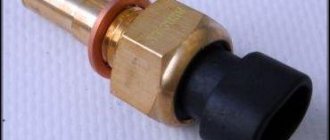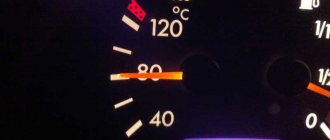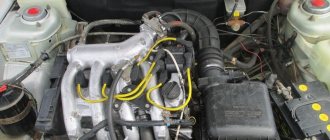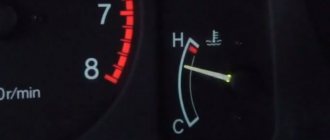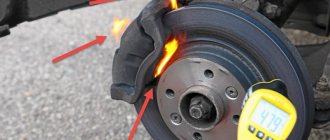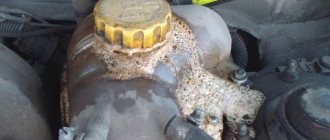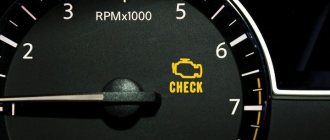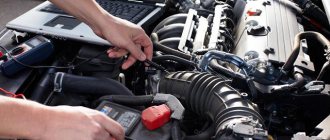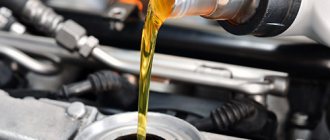The stability of any vehicle depends on the operating conditions and technical characteristics of the internal combustion engine. An indicator such as engine operating temperature depends not only on environmental conditions, but also on many operational factors. If this parameter corresponds to the calculated value, i.e. is within the acceptable range, the power unit provides maximum energy output for a long time. Optimal operating conditions of the internal combustion engine create the best conditions for the functioning of all vehicle systems.
What should be the operating temperature of the engine?
When fuel mixtures burn in the engine cylinders, a huge amount of heat is released. In the combustion chambers the temperature reaches more than 2000°C. The design of the power units includes a cooling system, the elements of which remove heat from the working units. Thanks to the efficient operation of the internal combustion engine cooling system elements, the thermal regime is maintained within optimal limits from +80 to 90°C. There are certain types of motors for which the standards have been extended to 110°C, most often these are air-cooled mechanisms.
When the engine operates at optimal temperature conditions, the best conditions are created for:
- Complete filling of cylinders with air-fuel mixtures.
- Stable operation of the power unit while driving.
- Reliable operation of vehicle mechanisms and systems.
Deviations from the norm in temperature conditions of power units
Temperature readings inside the engine can be seen on a device located in the interior of any modern car.
What does exceeding the normal operating temperature in the engine cause? At ultra-high temperatures, the technological thermal clearances of metal elements are violated. This causes the following negative changes in the operation of the power unit:
- accelerated wear of working units and parts;
- deformations and breakdowns of mechanisms;
- reduction in engine power;
- occurrence of detonation;
- unauthorized ignition of fuel.
What does the concept of low engine temperature mean? If, while the car is moving, the gauge needle is below the recommended temperature level, there are good reasons for alarm. The unheated fuel-air mixture condenses and settles on the cylinder walls. When condensation enters the oil pan, the engine oil dilutes. The technical properties and characteristics of the lubricant deteriorate sharply. During prolonged operation in low thermal conditions, the components and parts of the power unit quickly wear out and become unusable.
Gasoline engine operating temperature
The operation of each internal combustion engine is accompanied by the release of heat. The working elements of the motor operate under high temperature conditions.
When lowering the piston to the lowest point, a large amount of energy is expended, and at the same time heat is released. Elements of power units are made of metal. As you know, when heated, this material expands. In the manufacture of engine components and parts, special thermal gaps are provided, designed to heat the products to optimal values. To prevent jamming, the engine design includes an engine cooling system.
What is the optimal operating temperature for a gasoline engine? The operating temperature of gasoline power units, both carburetor and injection, should not exceed +90°C. The coolant's job is to maintain a constant engine temperature at the proper level.
Interesting: There is a concept of “dangerous engine temperature”. For gasoline-type internal combustion engines it is 130°C. After reaching the limit values, jamming of the power unit elements may occur.
Important: After turning on the engine and further moving the vehicle, the operator constantly monitors the operating temperature of the internal combustion engine. Deviations indicate problems in the cooling system:
- An increase in temperature in a gasoline engine leads to boiling and rapid evaporation of the coolant.
- As its quantity decreases, the engine temperature will rapidly increase.
- Under the influence of high temperatures, the metal will begin to deform and expand in volume.
- The dimensions of the parts will be greatly changed.
- As a result, the motor will jam.
To restore the performance of such an engine will require an expensive overhaul of the vehicle.
MAIN CAUSES OF OVERHEATING
- loss or decrease in the amount of coolant in the cooling system below a critical level;
- malfunctions of the cooling system;
- consequences of incorrect ignition adjustment or use of low octane fuel.
You can lose a large amount of antifreeze if a fistula or a decent-sized crack forms in the cooling radiator housing or in the places where the rubber pipes are attached due to impact or overload. As the antifreeze leaks out and its amount in the cooling system decreases, the pressure in the system will increase, which will provoke intense squeezing of the liquid into the expansion tank or increase the flow through the leak. A sign of a malfunction will be a small puddle of antifreeze after stopping the car.
Advice!
Before attempting to open the hood and see where the antifreeze is leaking, be sure to turn off the engine, otherwise drops of hot antifreeze falling on the rotating fan blades may unpleasantly “wash” the driver.
A common cause of boiling and critical overheating of the engine is considered to be a stop in the circulation of antifreeze due to the failure of the cooling system pump, temperature sensor or thermostat.
In most cases, the cause of failure and jamming of pump bearings is ordinary water or old antifreeze used as a cooling liquid. Salts dissolved in water or antifreeze decomposition products can “tightly” grab the pump bearings at the most inopportune moment. For the same reason, an important control element of the cooling system, the thermostat, fails. A situation arises when the radiator remains cold, but the engine overheats.
The most “problematic” scenario of engine overheating can happen if gasoline with a low octane number is filled into the car’s tank or the ignition timing is incorrectly adjusted. The reason is the burning out of part of the mixture in the exhaust system. Overheating will not be intense, but if a similar situation occurs again, its consequences may lead to engine failure.
As a result of deep overheating for 15-20 minutes:
- the geometry and dimensional accuracy of the engine head is lost;
- piston rings burst and collapse;
- pistons made of aluminum alloy are melted and, in some cases, destroyed;
- Connecting rod and main bearings fail due to loss of oil pressure due to its overheating to a superfluid state.
Important! If, as a result of overheating, the engine begins to gain speed - this is a sign of the onset of big problems, immediately turn it off at any cost. But do not pour cold water on the engine head - this will only increase its deformation.
Video about the causes of engine overheating:
THIS VIDEO DOESN'T WORK
What causes engine overcooling?
The phenomenon of hypothermia also negatively affects the quality of operation of the power unit. Most often this happens in winter or when operating a vehicle in difficult climatic conditions of the far north.
The operating temperature of the engine in winter can be sharply reduced while the car is moving. At the same time, flows of cooled air blow over the radiator and the entire power unit. As a result, the coolant sharply lowers the engine temperature, even if it is running at full load.
Using water as a cooling medium
The use of water to cool the power plant in winter is not recommended, but is allowed. The system must be filled with already heated water to avoid difficult starting of the engine with increased wear of parts. The radiator and motor must be insulated. Heated water must be poured with the drain valves open several times. Then close the taps, fill the system and start starting.
After the end of the trip, the liquid must be drained when it cools down to 45-50 degrees. If you empty the system immediately upon arrival, cracks and other defects may appear. Leaving the water system in frosty conditions is unacceptable. When freezing, the liquid will expand and render the engine, radiator and other components unusable.
Diesel engine operating temperature
Maintaining the operating temperature of a diesel engine is a necessary condition for the optimal functioning of vehicle mechanisms and systems. The operating principle of a diesel engine is fundamentally different from a gasoline engine. Here the fuel mixture is not prepared in advance. Air enters the chamber first. With strong compression, the air mass heats up to +700°C. At the moment of fuel injection, an explosion occurs, followed by uniform combustion of the resulting mixture. As a result, the piston moves to bottom dead center.
Diesel temperature depends on the following factors:
- motor type;
- ignition delay period of the air-fuel mixture;
- quality, uniformity of fuel combustion.
It is believed that the optimal operating temperature of the engine should be in the range of 70 – 90°C. The permissible maximum for diesel power units operating under heavy loads is +97°C, no more.
Advice: If the diesel engine is in good condition, it is recommended to warm up the coolant to a temperature of at least +40°C before driving. In severe frosts outside the car, the engine may begin to warm up only when driving. At first, it is recommended to engage a lower gear. In the future, the load on the engine should increase gradually, only after the temperature rises to at least 80°C.
You are not striving enough to realize yourself
You can ask a fair question: what does self-realization have to do with it? It's simple: activities that you like, your hobbies, are what you can use to realize yourself.
No matter what we strive to achieve in life, it is how much we want to achieve our goals that ultimately becomes the deciding factor in achieving them. Unfortunately, too many people try to limit their desires and tell themselves and others that they don't need incredible success.
However, such thinking is dangerous. When we limit the scope of our desires, we put barriers to what we are willing to do to achieve our goals and success in life. When this happens, we limit the scope of our motivation and interest in any particular activity and overall sense of satisfaction.
Lack of interesting and desirable goals can easily reduce our motivation and make us feel like nothing interests us.
